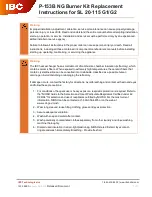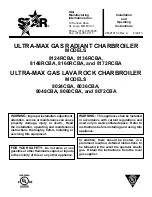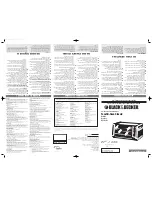
Align the flue turret with the 4 holes on the appliance and screw
down. See Fig. 16.
Refit the fan. Do not use any sealant on the joint. Replace the
inner casing cover.
Seal the gap around the duct with the flexible seal provided and
make good. See Fig. 22.
11.6. FITTING FLUE BENDS
Flue bends are an optional extra, the 90° bend supplied
singularly and the 45° bends being supplied as a pair. The bends
can be fitted in any combination as long as the combined
equivalent flue length plus length of flue duct does not exceed
3000mm. One 90° bend is equivalent to 1000mm of flue duct
and one 45° bend is equivalent to 500mm of flue duct. See Fig.
22a. In between flue bends (or between first bend and vertical
take-off adaptor) there is no difference in the length of the air
duct and the flue duct. Between the first bend and the flue turret
the air duct needs to be 14mm longer than the flue duct. After
the last bend the flue duct needs to be cut 15mm longer than
the air duct to fit into the terminal. Note the swaged ends of the
air ducts and the flue ducts must be removed to connect into the
flue bends and all joints between bends and flue must be sealed
with silicone sealant.
11.7 FINAL INSTALLATION
Check that all the water and gas connections have been
tightened.
If a facia mounted programmer is to be fitted follow instructions
with the programmer..
Hinge down the facia as described in Section 14.3(c).
Connect the mains electrical supply to the appliance at terminal
ST 12 See Fig. 8. Connect any room and/or frost thermostats.
The electrical leads must pass through the appropriate space in
the control panel and be fixed with the cable clamps provided.
See Figs. 11 and 12. Refit the facia panel.
Test the gas supply pipework up to the appliance for soundness
as indicated in BS 6891.
Refer to Section 12 for a full description of the filling, venting and
the pressurising of the system.
If the appliance is not to be commissioned immediately, replace
the cabinet front panel. Check that the gas supply, the electrical
supply and the water connections are all turned off.
If the premises are to be left unoccupied during frosty
conditions, then drain the appliance and system. For short
inoperative periods, leave the appliance under the control of
the built in frost thermostat or the remote frost thermostat (if
fitted) or leave operating continuously with the room
thermostat set at 6°C.
15
Fig. 22a. Fitting the flue bends to the intermediate sections of the flue duct.
Flue and air duct = L
2
Flue and air
duct = L
2
Air duct L
1
Flue duct L
1
Ð 14mm
Air duct L
1
Flue duct L
1
Ð 14mm
Air duct L
3
Flue duct L
3
+ 15mm
Air duct L
3
Flue duct L
3
+ 15mm
















































